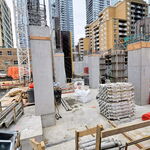T3G
Senior Member
Because Spadina station was first built on the Bloor line, and Spadina was the nearest cross street. When line 1 was extended there, it was a choice between naming it that, or Lowther, for a minor side road nearby. Considering how few people in this city have heard of Lowther (and have heard of Cedarvale), and considering that the station is basically on the curve at Bloor and Spadina, I can easily see why they chose to name it what it is.why, of two stations on Spadina Road, is one called Spadina and the other not?
Dupont is on Spadina, so naming it for the street it's on would cause the same problems as keeping an Eglinton and Eglinton West station on the Eglinton line.
The lesson here is supposed to be that train station names are only one part of the navigational puzzle; treating whatever name they have as absolute will lead only to ruin, and that if you're navigating to a specific destination by address, you're going to have to pay more attention.
Why wouldn't you do this in the first place? Transit maps are not supposed to call out every possible destination in the city. And if unique station naming by neighbourhood were in place, how exactly would that help you with figuring out what station you want? Would Avenue station being called Allenby have helped future you in any capacity with 366 Eglinton W?The solution to these problems is to look at a street map first, find the station which is actually closest to your destination (rather than guessing based on its name) and then to find the routes which take you there.
Both of these are needlessly lofty examples. When it comes to naming a person, there are no wayfinding considerations and the amount of general external contextual considerations are, compared to naming a transit station or stop, much smaller. As for a city, the overwhelming majority of human settlements in the world were named in a standalone way, not in the context of other places around them. If you wanted to, you could start a village and name it Moria, or Hogwarts, or Narnia.Mary O'Neill and Peter Smith have two boys and two girls. How do we name them?
Option A:
- Peter-the-First O'Neill-Smith
- Peter-the-Second O'Neill-Smith
- Mary-the-First O'Neill-Smith
- Mary-the-Second O'Neill-Smith
Option B:
- Joshua (Smith)
- Mason (Smith)
- Susan (Smith)
- Chloe (Smith)
I'm arguing option B. Sure, option A has more data but speaking to the video that sparked the conversation there is a lack of unique traits (he had a rant about inbreeding). If you think the goal of naming is maximum data conveyance then option A is a clear winner. Option B has unique names and the common higher level taxonomy is optional (e.g. (Toronto) Pearson). You might not have all that extra data but conversations and addressing people is simpler.
Going back to the founding of the city, what would be the better name of this place?
Option A: Ontario-shores-upon-the-Don
Option B: Toronto
Argument back in the 1800s ensues... how can you argue against option A, look at all the useful data in the name. Nobody knows where or what Toronto is! It is here where we are standing because we name it so. This will never catch on and is a bad idea because it is meaningless.
Yes, there is a stop for the Cosburn bus at Cedarvale Avenue. I don't see this is a problem, but to people who blindly go by subway station names, and, apparently, no other forms of context known to the human race, this could be devastating. Imagine this person to be on their way back from Cedarvale station to their residence along Cosburn, and they hear Cedarvale Avenue next, and they think that they've actually gone nowhere at all, despite having been on the go for an hour and change.Is ending up on Cedarvale Avenue in East York something a subway rider can do?
Last edited:




